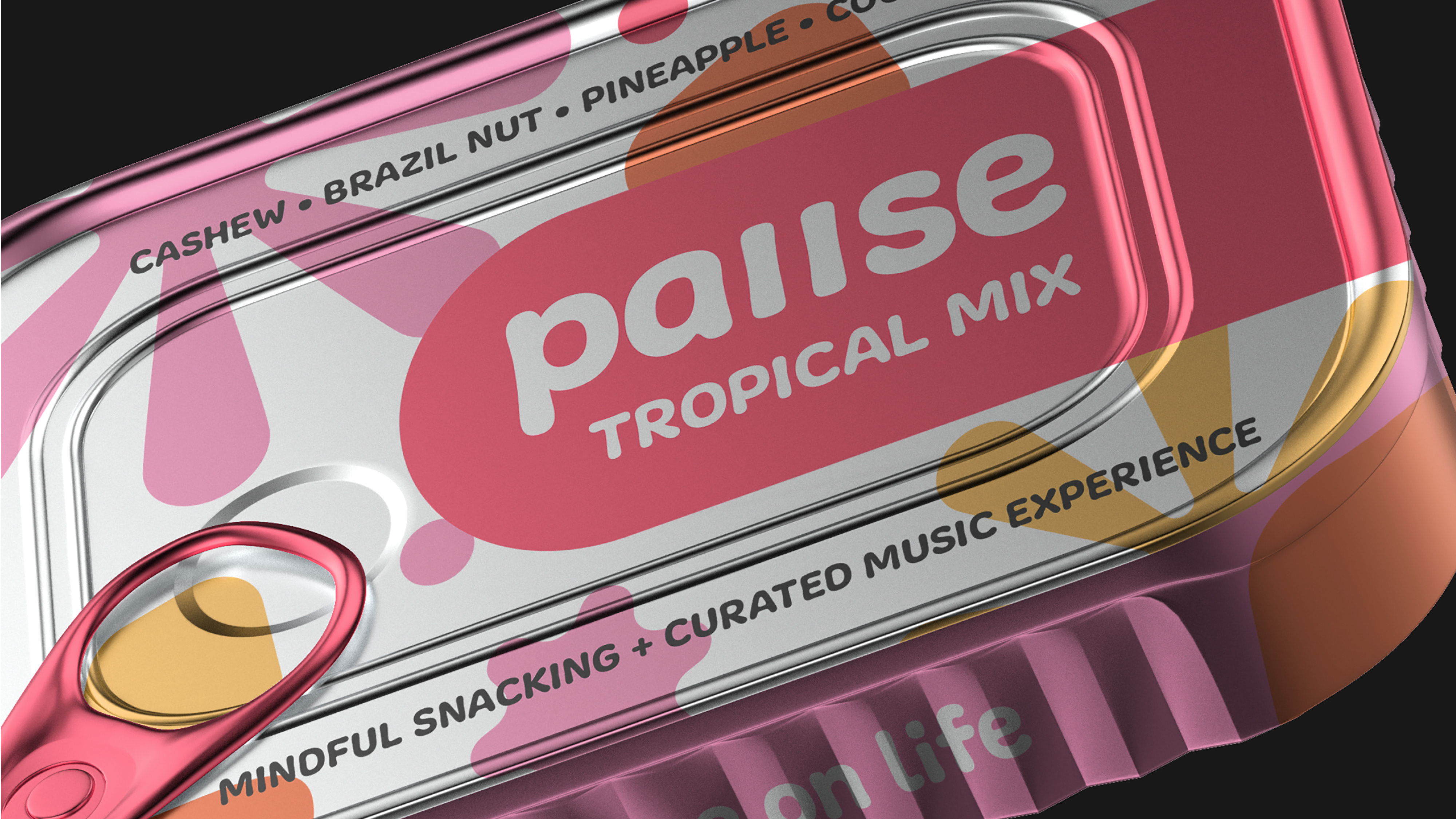Print Advertisement for Plugs.
What is it?
Simple Thesis: If we’re going to continue to employ gendered marketing, then transmasculine people deserve to purchase menstrual products that validate their identities and experiences.
Plugs is a line of menstrual products—including tampons, pads, and a menstrual disc—marketed to men. The branding, packaging, and advertising that I created for this project examines the concept of gendered design. As our societal understanding of gender becomes more expansive and fluid, I have seen a significant gap in the menstrual-product market for transmasculine** people.
Plugs humorously explores the “For Men” category of personal-care products and everything that phrase entails. Through this project, I poke and prod at the necessity of gendered markers in design by marketing menstrual products to transgender* men and other transmasculine people using a hyperbolic but conventionally masculine tone of voice.
Okay, but why?
It’s funny.
Humor is an essential part of my life, and I want it to continue influencing my work. Senior Capstone is a completely open-ended, self-driven project. Yeah, I could have spent nine months working on something “serious,” but the thought of putting my time and energy into something that I get a kick out of is way more appealing.
Humor is an essential part of my life, and I want it to continue influencing my work. Senior Capstone is a completely open-ended, self-driven project. Yeah, I could have spent nine months working on something “serious,” but the thought of putting my time and energy into something that I get a kick out of is way more appealing.
I am fiercely passionate about trans joy.
Gender is a social construct that has warped and shifted drastically from culture to culture throughout all of human history. Being transgender affects my daily lived experience as well as the experiences of my dearest friends. Whether purposefully or not, much of my art explores themes of self-expression and gender. I am a proponent of transgender people’s human right to live joyful and fulfilling lives in safe, celebratory environments.
Gender is a social construct that has warped and shifted drastically from culture to culture throughout all of human history. Being transgender affects my daily lived experience as well as the experiences of my dearest friends. Whether purposefully or not, much of my art explores themes of self-expression and gender. I am a proponent of transgender people’s human right to live joyful and fulfilling lives in safe, celebratory environments.
Packaging design performs & informs gender.
I go into more detail on this subject later. To summarize, our genders are expressions of our personalities, and they’re driven by joy. In a capitalist society, our joy is mediated by consumption; this means that we consume and collect in order to express ourselves. When consumption is tied so tightly to expression, the visual aesthetics and messaging of the products we buy become reflections of our gender—and so perform gender themselves. The extreme result of this is a system of hyper-masculine visuals and language that “allows” men to consume otherwise mundane products. Confused? It’s okay. I just ask that you approach this project with an open mind and curious spirit.
I go into more detail on this subject later. To summarize, our genders are expressions of our personalities, and they’re driven by joy. In a capitalist society, our joy is mediated by consumption; this means that we consume and collect in order to express ourselves. When consumption is tied so tightly to expression, the visual aesthetics and messaging of the products we buy become reflections of our gender—and so perform gender themselves. The extreme result of this is a system of hyper-masculine visuals and language that “allows” men to consume otherwise mundane products. Confused? It’s okay. I just ask that you approach this project with an open mind and curious spirit.
Have you seen how ugly menstrual packaging is!?
For real, there is some truly heinous, outdated shit on store shelves. I began this project with the intention of weaving satire into actually appealing package design. Why buy something if it’s ugly?
For real, there is some truly heinous, outdated shit on store shelves. I began this project with the intention of weaving satire into actually appealing package design. Why buy something if it’s ugly?
Plugs packaging consists of cubic sleeve boxes with interior cubic tray boxes. The design is grid-based, featuring bold typography and minimal decoration. Wrap-around text leads the reader from the left side of the exterior to the top of the box, then back around again. These two planes of the box feature a distressed texture.
Boxes would be sealed with a black sticker in a shape corresponding to the absorbency level indicated on the front and side of the box (e.g., regular-absorbency tampons would be sealed with a black star sticker).
Though not produced for this project, a rendering of the unit packaging for Plugs tampons is shown to the right of the boxes. Each tampon would be packaged in a recycled-cardboard tube that heavily features the absorbency visual indicator. The shape is reminiscent of a shotgun shell. Each tube would have a scored tab that would be pulled to open the unit. Since Plugs tampons wouldn’t include applicators, the unit packaging is more compact and more easily disposed of—and more tampons are able to be sold in one box.
:30 TV Spot for Plugs Menstrual Products.
Plugs products are differentiated visually through three colorways. The values are saturated, often complementary pairs that feature an additional off-white.
The saturated red is the overarching brand’s primary color. Red differentiates Plugs from most existing menstrual-product brands which use black, pinks, purples, corals, and greens.
Saturated, warm hues are less commonly used for marketing “for men” products than desaturated cool hues. I argue that using these intense, borderline fluorescent values appeals to a young male audience that is less afraid to experiment with color.
Absorption quality is indicated through a set of four symbols with increasing quantities of protruding points in correlation with increased absorption level. The symbols are displayed on the front exterior and side right exterior of the packaging as well as via the sealing sticker on top of the box.
The disc’s packaging features only a circle in place of the other absorbency symbols because there is only one level of absorbency: 1.2 fluid ounces. Absorbency is expressed in words with “Light,” “regular,” “Heavy,” and “Super;” as well as “Featherweight,” “Middleweight,” “Cruiserweight,” and “Heavyweight.”
The Plugs typographic system employs condensed treatments of two sans serif typefaces: Din and Arial. They connote directness, efficiency, and modernity.
What Even Is Gender?
Yeah, that’s my question, too!
The simplest way of understanding gender is to examine it as a performance. Humans are primarily social creatures; our communities thrive through cooperation and relationship-making. By forming relationships, no matter how surface-level, we gain chances to observe other people’s behaviors. Mirror neurons in the pre-frontal cortex allow us to easily mimic those observed behaviors as performance. At a certain point, a number of people performing in a particular way becomes a trend. In this way, we can think of gender as a trend, too; it is a particular way of conducting oneself. Our performance is executed publicly in anticipation of external perception.
The gender binary is an idea that such a performance exists at two extremes: male and female. This binary is predicated on an assumed, inherent link between genetics, primary and secondary sexual characteristics, and performance. The reality of human gender is far richer and more complex.
A binary interpretation of gender is not, by any stretch, representative of every culture; in fact, many indigenous (i.e., pre-colonial) cultures have pluralistic interpretations of gender. But, we have to examine the binary as it exists in Western societies in order to understand how package design plays a role in defining and enforcing gender norms.
Packaging performs + informs gender.
Package design has the capacity to validate and alienate entire audiences of people based on gender. Particularly in the beauty and personal-care industries, package design is a medium through which gender is performed and upheld through associations of color, material, imagery, ornamentation, and language. These associations are based on the binary, social conceptions of masculinity and femininity as distinctly separate and imbalanced.
Conventionally masculine packaging for personal-care products sits in direct contrast to feminine packaging. Male-targeted products are packaged in cool hues, typically blues, greys, and black. Metallics are silver and gold. The packaging often features a machine aesthetic, playing up connotations of power and logic. Straight lines and other angular shapes are more common than rounded, organic shapes. Overall, pattern and ornamentation is limited to reserved patterns like stripes, with exceptions made for particularly wild, animalistic treatments.
Products “for men” often express a sort of mechanical aesthetic. The product language emphasizes technical prowess and power, typically describing products as tools. There is an unstated but understood superiority—an assertion of a professional grade—inherent to men’s products thanks to the hierarchical association of masculinity with quality and precision. The product language also speaks of independence and professionalism, emphasizing the respect-seeking traits of social interaction as opposed to community-seeking traits that would typically be associated with femininity and women.
Euphoric Consumption
In a Capitalist society, identity is based around consumption and ownership. Joy and experience are commodified. Because gender is simply participation in what makes us feel joyful, it only follows that gender in Capitalism would be defined by consumption, as well. The gendering of products can be highly validating for transgender people. Because gender and consumption are linked, consumption is a major source of validation. Consuming products “for men” is one part of a particular male performance—I am a Man who purchases Man products, which makes me a Man.
Dysphoric Consumption
As much as gendered packaging has the capacity to validate consumers, it is capable of alienating the same groups. Menstrual product packaging is a highly influential factor in the transmasculine experience. Menstrual products are often found in “feminine care” aisles, and the packaging typically, heavily incorporates language, illustrations, and motifs conventionally associated with women and femininity.
Trans people who menstruate still have to purchase these products, but the participation in femininity might in some cases be extremely uncomfortable for them. Additionally, the insistence of an inherent link between menstruation and femininity alienates from femininity and womanhood those cis women and transfeminine people who do not menstruate.
My goal for this project was not to find an answer to the question, “Is gendered package design bad for us?” The question deserves more than a simple yes or no answer because our capacity to participate in gender is so heavily restricted by Capitalist values.
While our individual needs overlap much more than they differ based on gender, there is still a psychological value to consuming products that are specifically targeted toward our genders. As our society slowly but surely becomes more aware of the fluidity and baselessness of gender, it will be interesting to note how design trends and audience profiles change to meet the shift.
I extend special thanks to:
Rick Febre, Christine Gallagher, Jun Bum Shin, Lora Redwine, Güido Alvarez, and Deann García for their invaluable instruction and guidance as I worked toward completing my university degree.
Reese Bowes for his support and advice in the development of this capstone project.
The team at Morvil Advertising & Design for fostering my professional development and trusting my 18-year-old self to take on real design jobs.
Maria Hamilton for facilitating my initial steps into graphic design—I literally wouldn't be doing this as a career if it weren't for her.
Teresa Preddy and Hayden Wilcox for being amazing and for encouraging my work.
My parents, family, friends, and community for always supporting, loving and celebrating my authentic self. <3
Pic of me with my display at the capstone showcase in Portland :)
Quotes cited from:
McIntyre, Magdalena P. “Gender by Design: Performativity and Consumer Packaging.” The Journal of the Design Studies Forum, vol. 10, no. 3, 2018, pp. 337–358.
McIntyre, Magdalena P. “Gender by Design: Performativity and Consumer Packaging.” The Journal of the Design Studies Forum, vol. 10, no. 3, 2018, pp. 337–358.









